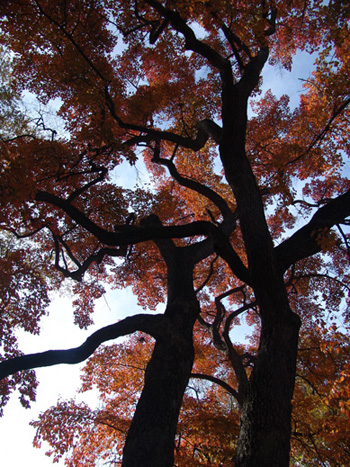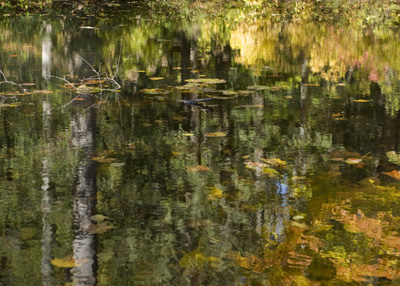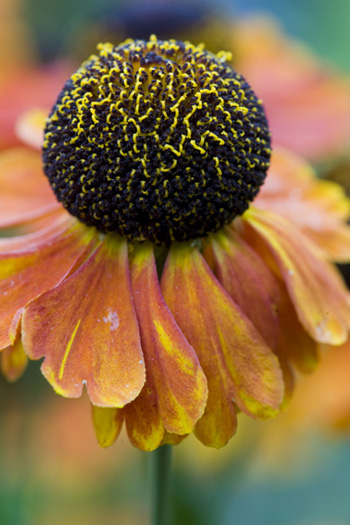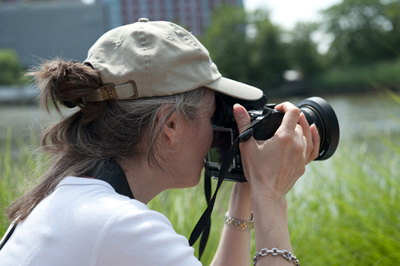Photographing Autumn

Autumn is upon us in the Delaware Valley and I find myself scheduling several early morning and late afternoon “golden hours” each week to try and capture the fleeting transition of the flora around us. It is this fleeting nature of autumn that captivates me this time of year as a photographer. One day, just a few hours or even just a few seconds can make an entirely different moment any time of year, but autumn seems to be exceedingly fleeting and what might be a beautiful scene of fall color one day might be a bare landscape the next.

Reflections on the pond at Mt. Cuba. photo credit: R. Maurer
There is so much to take in visually and I also find my sense of hearing and smell heightened at this time of year. Just this weekend the sound and scent of Eastern white pine needles toasting in the afternoon sun took me back to sleeping on a bed of these needles in a pine forest when I was about 10 years old. I use all my senses to frame my vision for a photograph. Personally, I’m trying to convey meaning, trying to listen to what nature is saying and trying to excite the senses with my finished images; but every photographer has a different vision for their work.

October colors of Helenium 'Mardi Gras'. photo credit: R. Maurer
Some tools I always take with me into the field along with my camera and lenses are my tripod, graduated neutral density filters and circular polarizer. I carry the tripod with me everywhere as I often find a need for it even on the brightest of days. The circular polarizer minimizes reflections off of water, leaf surfaces and structures when at 90 degrees from the sun. Graduated neutral density filters help to compensate for exposure differences between a brightly lit sky and foreground at times such as sunrise and sunset. I might even pack along a neutral density filter to control exposure for movement.

Rhoda Maurer capturing the "fleeting transition of flora" with her camera. photo credit: B. Rahlings
Autumn is an amazing time of year; moments in time to become closer with knowing ourselves as photographers, artists and human beings. It’s also a good time to brush up on your skills as a photographer and artist. Join me October 22nd and 29th for a two part workshop on the techniques and creative aspects of digital photography held at the Scott Arboretum. Session One will cover topics such as: composition, filters, exposure compensation, white balance, shutter speed, and depth of field. Session Two will be an opportunity to explore your own creative vision using the techniques learned in Session One. Register online or by calling the Scott Arboretum office at 610-328-8025.





Bill Rahling
Posted at 22:14h, 09 OctoberRhoda – Really like the macro of the Helenium. Have you done any experimenting with your Nikkor 28mm PC lens as far as using extension tubes or teleconverter? I’m still just learning what this lens is all about.
Bill
Jody Downer
Posted at 09:17h, 10 OctoberWow – spectacular pictures!
Eunice Silver
Posted at 18:22h, 14 OctoberGorgeous pix! Let me know if you’re ever having a show/sale.
Rhoda Maurer
Posted at 07:51h, 15 OctoberBill – I’ve been using my 24mm PC-E lens with mostly landscape work. Just this weekend I was able to capture a beautiful wild blueberry growing out of an old stump with a backdrop of a lake and fall color using this lens. I have not tried teleconverters or extension tubes with this lens since I use my 105mm micro for the macro work like the Helenium ‘Mardi Gras’ image in this post. I would be worth experimenting though!
Rhoda Maurer
Posted at 12:18h, 15 OctoberThanks Eunice – Did you link out to my personal blog as well to see more! http://ramaurer.wordpress.com/